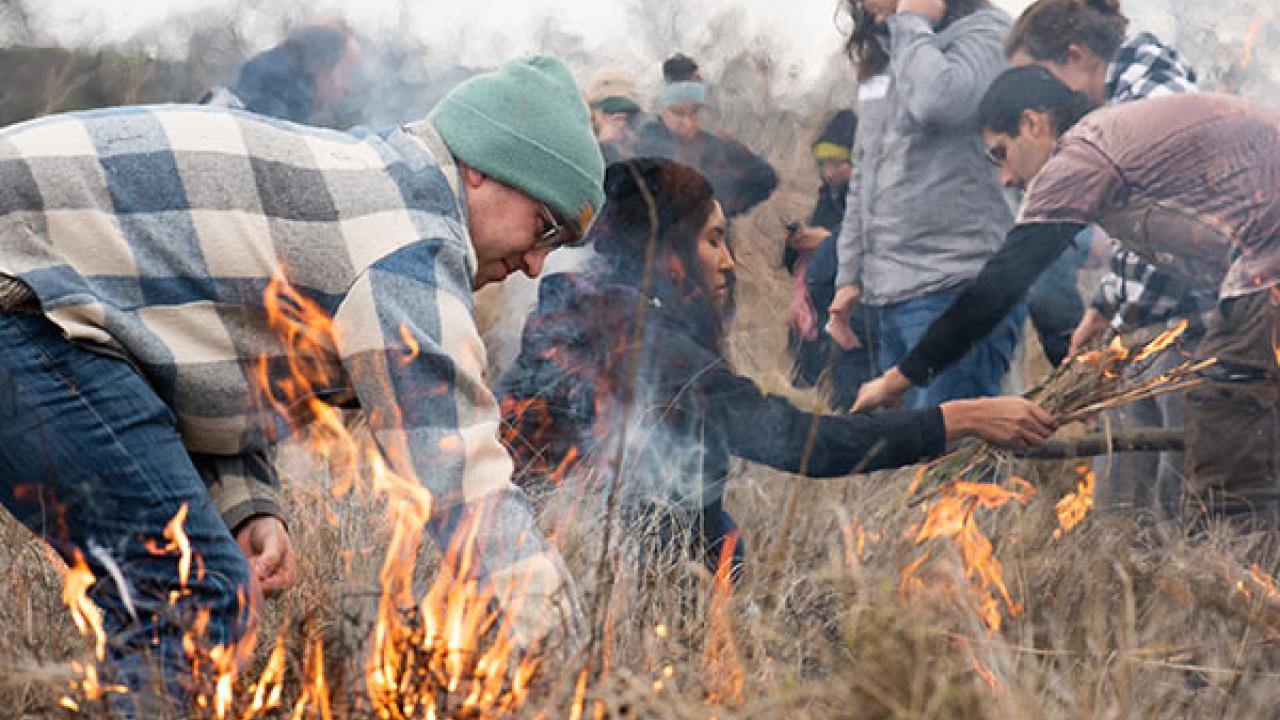When fire ravages forests, homes and lives, it can be hard to think of it as anything other than terrifying and something to be avoided at all costs. For thousands of years, Native Americans in what is now California and across the West treated and nurtured fire like the natural resource it is through the practice of cultural burning.
For non-Native people, cultural burns require a mental adjustment — one that views fire as restorative, not destructive. This is fire lighting, not firefighting.
As wildfires burn bigger, hotter and more frequently each year, state and local agencies, groups and landowners are increasingly looking to Native people — the original land managers — for guidance on living with fire.
In early 2020, students and faculty from the University of California, Davis, partnered with regional tribes to take part in cultural burns in Northern California as part of a UC Davis Native American studies course called “Keepers of the Flame.” The course is funded through the Southwest Climate Adaptation Center, Yocha Dehe Endowed Chair in California Indian Studies, and the UC Davis Department of Plant Sciences.
On a February day in Mariposa, just south of Yosemite National Park, they were joined by representatives from state agencies and nongovernmental organizations who came to observe, listen, learn and light.
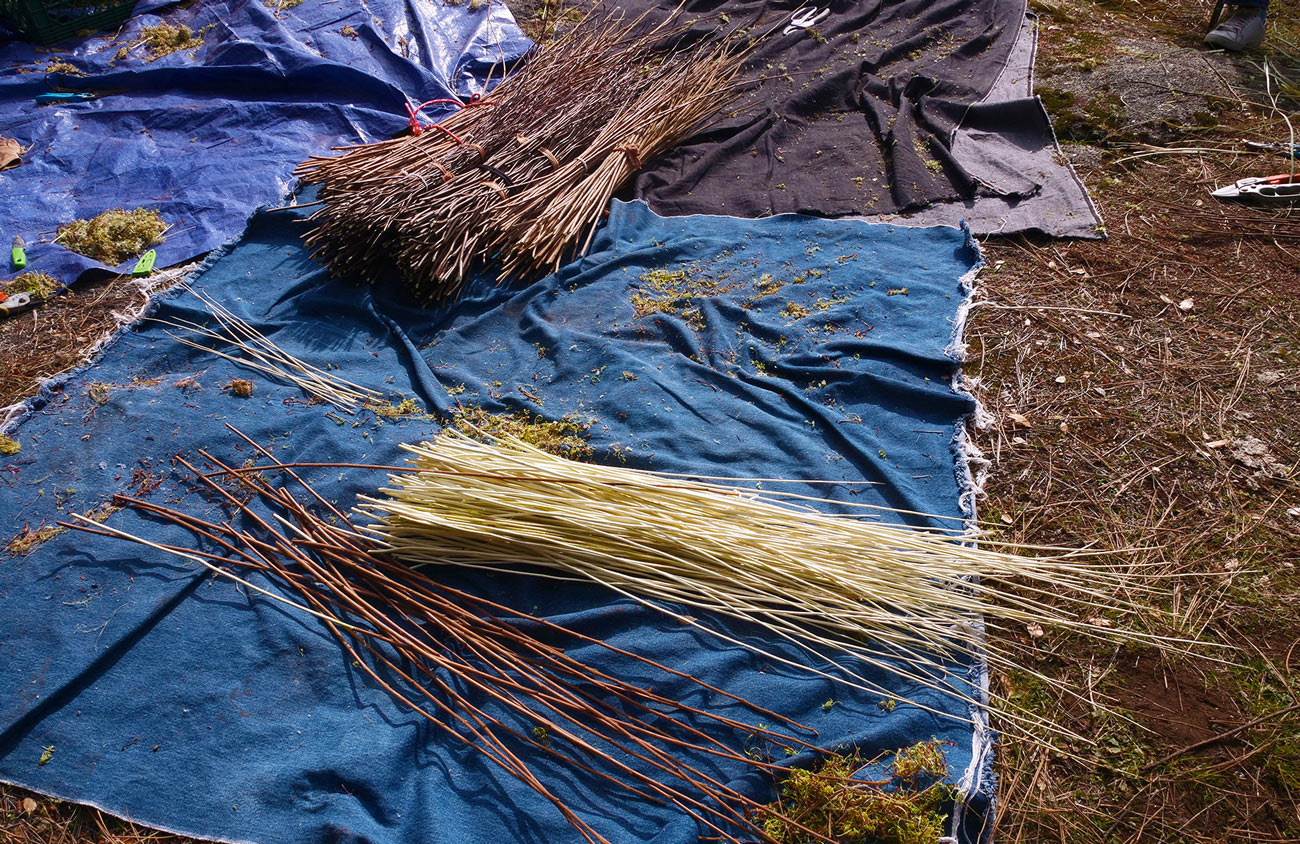
First growth
Julie Dick Tex is standing in a patch of sourberry bushes holding pruning shears. She leans over, nose to branch, to inspect their tips and stems, looking for the strongest, straightest shoots.
“My mother always taught me that first growth is best,” said Tex, of the Western Mono tribe. Come late spring, small, red berries will emerge beneath velvety leaves. For now, the stems are leafless and gray.
A cousin to sumac, the sticks of the sourberry bush play a leading role in the basketry of several Native American tribes in California.

“We can’t carry on our culture if we can’t use our baskets,” she said, adding that traditional baskets require sourberry.
But sourberry sticks can’t be useful for basketry without fire. Plants that are merely pruned rather than burned grow back bushy, crooked and weak. A gentle fire clears the brush, regenerates the plant and coaxes new shoots straight toward the sun.
“The burned ones grow straight,” Dick Tex said. “If you have a crooked stick, it won’t ever get straight. But here, I could pick my whole year’s source of material and be done.”
“Here” refers to about 400 acres of oak woodland and meadows in Mariposa. The site encompasses an ancestral village at least 8,000 years old that was once home to more than 600 Miwok people.
North Fork Mono Tribal Chairman Ron Goode invited Dick Tex here, along with about 50 additional tribal members, UC Davis students and faculty, state agency representatives and NGOs to conduct a cultural burn on a few acres of the property, which is owned by the family of his wife, Myra Kirk-Goode.
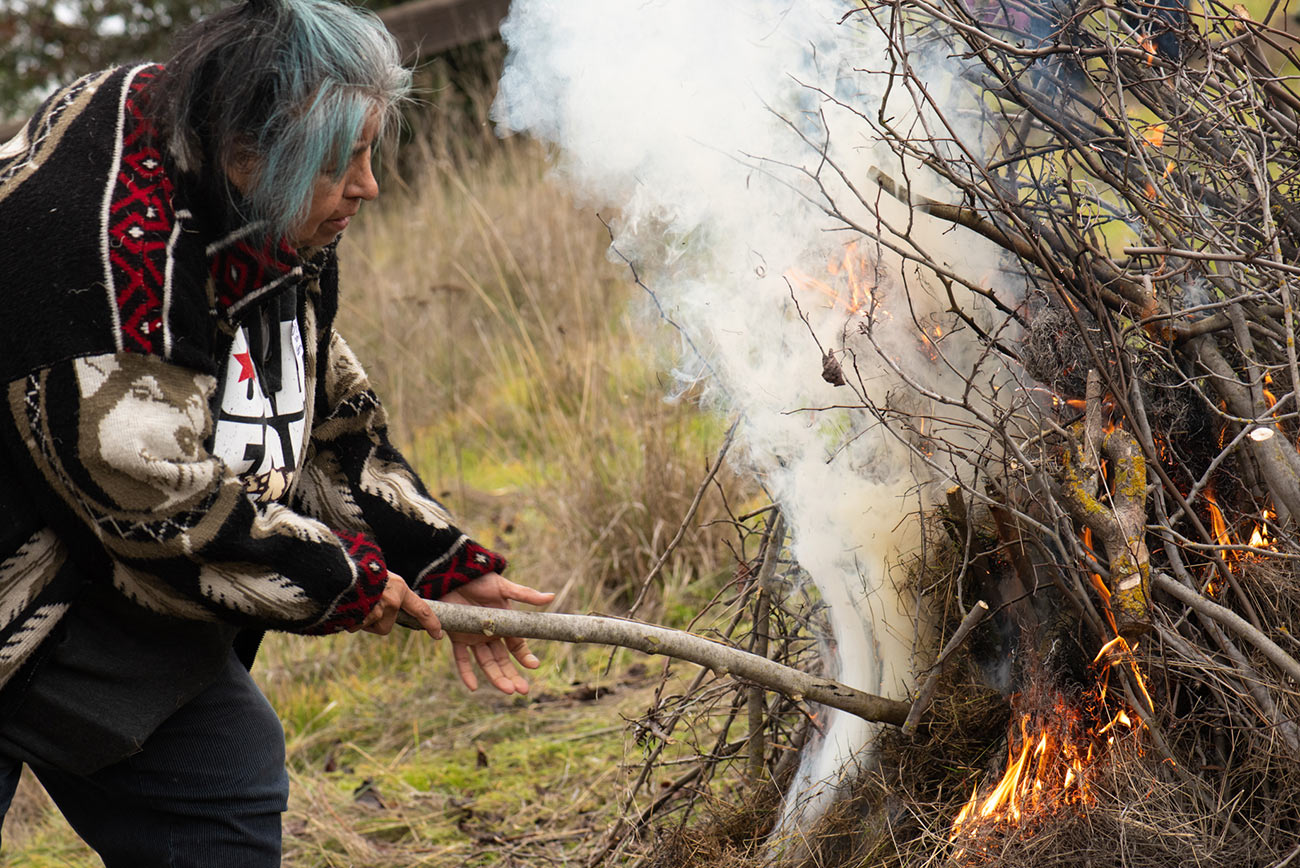
Cultivating fire
There’s a difference between cultural burning and just setting fire on the land. We use fire as a tool.
– Ron Goode
Historically, wildfires in California tended to burn frequently but at lower temperatures that maintained healthy soil, water and forests. Prescribed fires and cultural burns both serve to mimic those conditions, but they are not the same.
Similar to how the shift of one consonant transforms what was “scared” into “sacred,” so resembles the distinction between prescribed and cultural burns.
“Culture means ‘to cultivate,’” Goode told the group following a morning blessing and before the day’s work begins. “There’s a difference between cultural burning and just setting fire on the land. We use fire as a tool.”
Tribal elders, including North Fork Mono Tribal Chairman Ron Goode, lead cultural burning ceremonies at the Jack Kirk Estate in Mariposa to demonstrate and educate others about the practice. (Sinead Santich)
He explained that Native people burn to enhance vegetation, not just remove it. Reducing fuel loads is just one of many benefits fire holds for ecosystems. For millennia, Indigenous people worldwide have applied small fires to the land to renew plants and watersheds for food, wildlife habitat, medicine, basketry and other cultural uses.
When John Muir first walked to the Yosemite Valley not far from this property, he walked through wide meadows scattered with flowers and trees tens of feet apart — not a closed canopy forest. When a fire burned in Yosemite, it ate through grass and young trees, rarely gaining enough traction to burn with high severity.
Kat Anderson, an ethnobotanist with the UC Davis Department of Plant Sciences and USDA, wrote in her book Tending the Wild that what Muir was really seeing “were the fertile gardens of the Sierra Miwok and Valley Yokuts Indians, modified and made productive by centuries of harvesting, tilling, sowing, pruning and burning.”
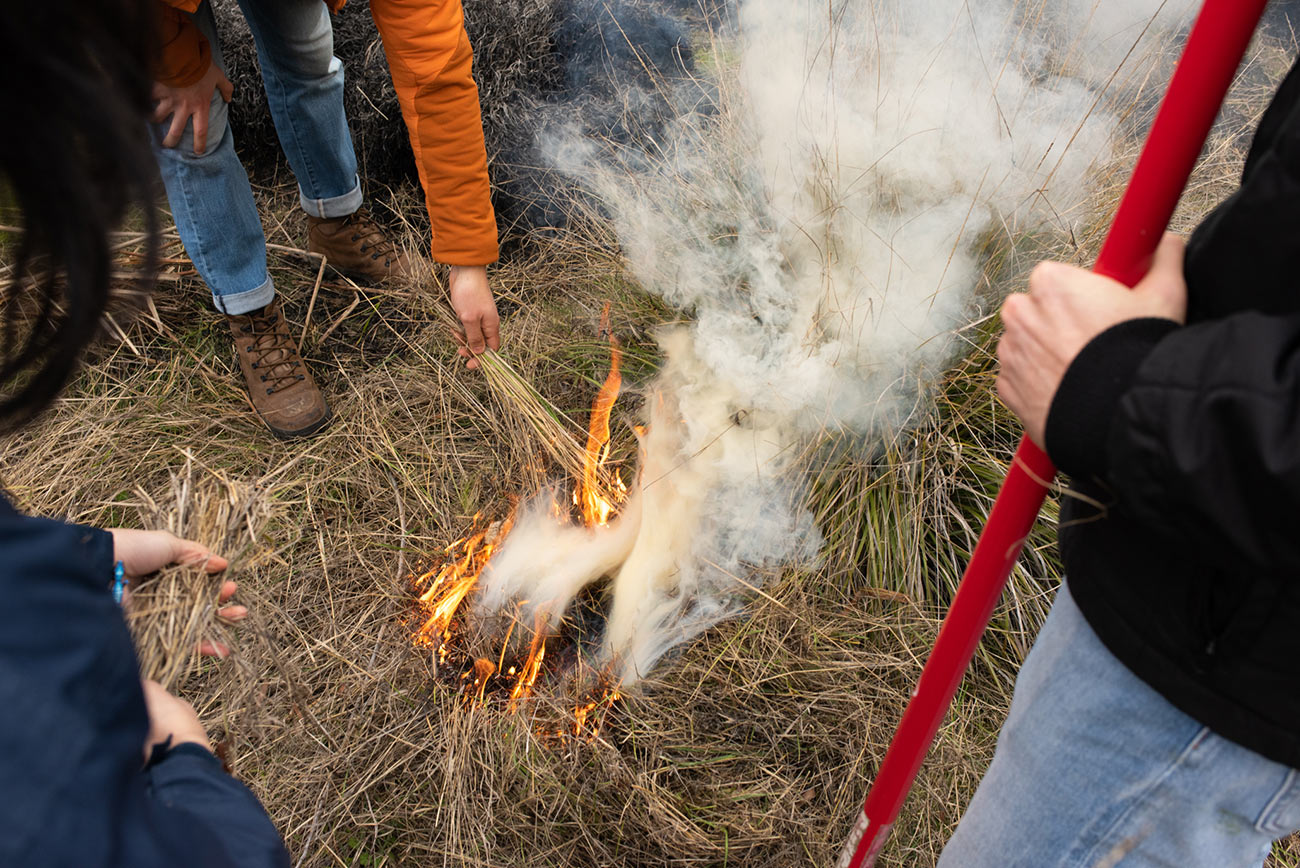
New life
We’re talking about new life. When fire agencies start fires, they don’t expect a return. My goal is restoration. Whatever I do, I want it to return.
– Ron Goode
Growing on a hillside behind Goode is a patch of sourberry and also redbud, which is prized by basket weavers for its tender, pink shoots and bark.
Reaching the point of restoration evident in this hillside took multiple years — not just a budget cycle — of prep work, burning, regrowth and reburning. That time commitment is an inherent challenge for management agencies.
This area was burned during smaller gatherings with the UC Davis students in 2018 and 2019. The results from those burns — strong, healthy, beautiful regrowth — bring tears to the eyes of some of the basket weavers present this year.
When Native Americans were removed and displaced, they not only lost access to their ancestral lands, they also were banned from the practice of cultural burning itself. With these losses came, too, the decline of practices, like basket weaving, that access to land and traditional plant materials afforded.
“We’ve been kicked off the land, but we’re now back and here to restore,” Goode said. “We’re talking about new life. When fire agencies start fires, they don’t expect a return. My goal is restoration. Whatever I do, I want it to return.”

Reciprocity
Before the Gold Rush, an estimated 4.5 million acres burned annually in California. In the early 1900s, the U.S. Forest Service adopted a policy of fire suppression that stayed in place for nearly 70 years. Native Americans, ranchers and private landowners could be fined for conducting burns on their properties. Since the 1970s, fire has gradually been reintroduced to the landscape but only at a fraction of what once occurred.
As wildfires and smoke events upend life in California year after year, some of the same entities that once banned Native Americans from cultural burns are now looking to them for advice. The proposition is sensitive and one that demands reciprocity, not just another opportunity to take from Native people, note the course’s instructors.
“I think it’s really important that we don’t think about traditional burning in a context where Native people are again being extracted from, such as sharing their knowledge about how to care for a place when they’re still federally unrecognized and don’t have land within their homeland,” said course instructor Beth Rose Middleton Manning, a professor in the UC Davis Department of Native American Studies. “So we’re teaching and learning from each other, but we’re also investing in justice so people can protect their homelands and cultural places.”
Earlier in the year, students and several tribal nations joined together for a workshop and cultural burn at the Tending and Gathering Garden in the homeland of the Wintun people in Yolo County. A collaborative effort between the Native American community and Cache Creek Conservancy, the garden grew from the graduate work of UC Davis alumna Shannon Brawley ’00. It’s also one of the few public gardens in the nation set aside for Indigenous people to practice traditional management methods and gather plants.

“Helping to facilitate these workshops is part of our goal to not just consume Indigenous knowledge but to give back in some way,” said Christopher Adlam, a Graduate Group in Ecology student who led the “Keepers of the Flame” class with Middleton Manning.
Also at the workshop were members of prescribed burn associations and collaboratives. Increasingly, grassroots groups like these — from Humboldt and Sonoma to Mendocino and Plumas counties — are working together to secure the needed permits, train volunteers and help provide the person power to conduct burns on private lands. Private landowners own about 40 percent of the 33 million acres of forest in the state.
“People give me hope,” Adlam said. “It’s people who are going to pick up the torch, help one another and do it safely. Ranchers used to burn 200,000 acres a year. I think the ranchers are going to be essential in bringing back fire to private lands. There are prescribed burn associations. It’s coming back.”
Renewed efforts have also begun at the agency scale. In late August, state and federal agencies signed an agreement to thin or intentionally burn 1 million acres per year by 2025, which is just one-fifth of the acreage burned in the first half alone of 2020’s record-breaking fire season but still twice as much as past years’ efforts.
What level of involvement tribes will have in those decisions remains to be seen, but there are positive signs of collaboration.
“I’m glad we have public land managers here like Cal Fire because they’re really seeing traditional knowledge in action and the commitment people have to these places,” said Middleton Manning. “Many state entities tend to leave tribes out. The California Environmental Quality Act did not require tribal consultation until recently. Things are steadily changing.”
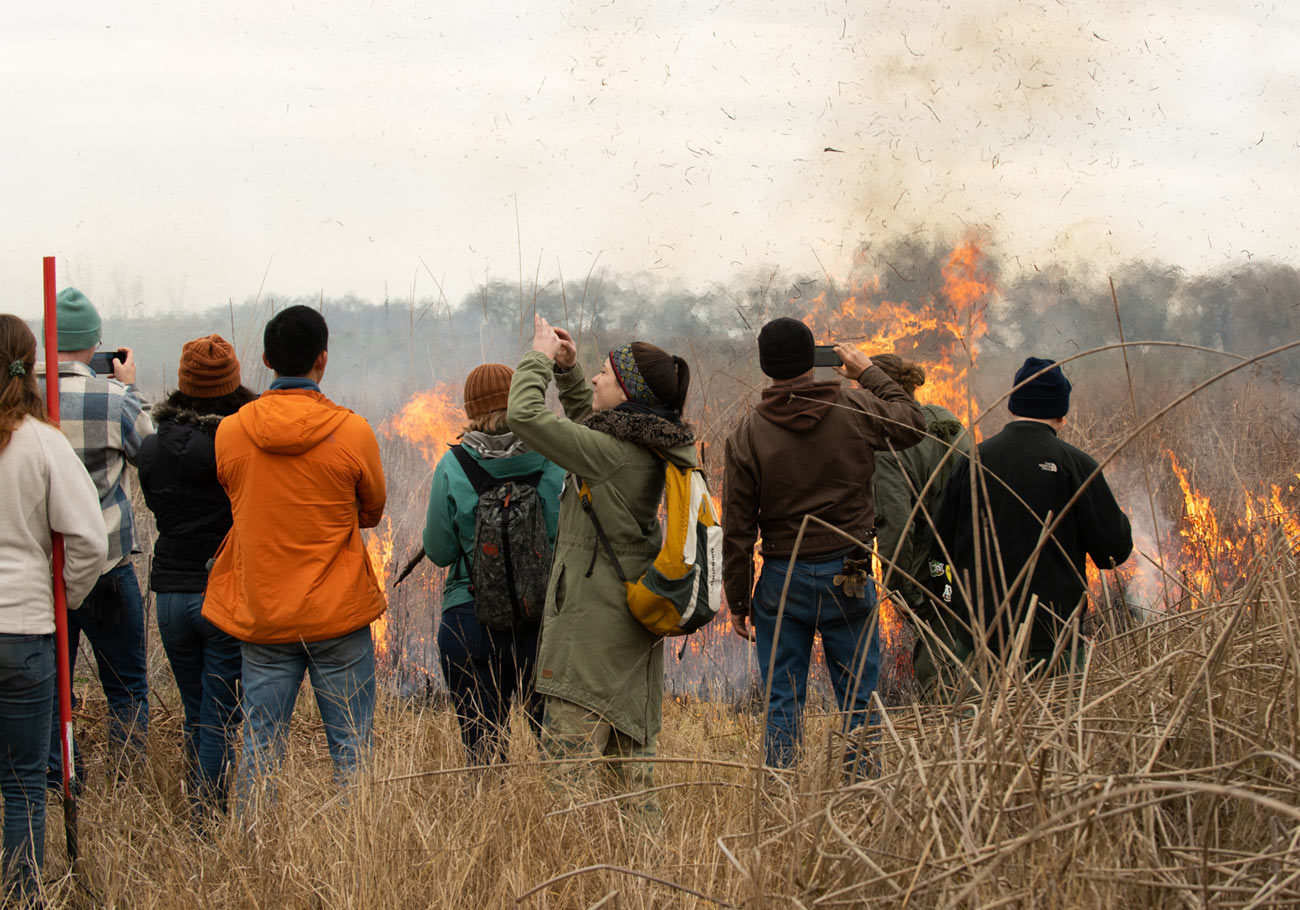
Good fire
This is an opportunity to learn from the originators of land management and ecological restoration.
– Jennifer Montgomery
In the Mariposa meadow, students and volunteers cut back brush and create burn piles. Tribal and state fire crews rev chainsaws and trim dead tree limbs. Great droplets of fire fall from a drip torch, and the outer edge of the field sizzles with the first crackling sounds of burning grass.
Danny Manning, assistant fire chief of the Greenville Rancheria, puts the group at ease as smoke rises: “If you see me worry, then you worry. If it’s your first burn, it’s OK to feel a little uneasy.”
This is the first cultural burn for Jennifer Montgomery, director of the governor’s Forest Management Task Force.
“One of my goals for coming here is to do a better job of connecting with Indigenous people here in California who can say, ‘Here’s what’s appropriate for our area,’” Montgomery said while walking through shrubs toward the meadow. “This is an opportunity to learn from the originators of land management and ecological restoration.”
Class member Diamond Lomeli is a junior at UC Davis majoring in Native American studies. She is also a member at large of the Yocha Dehe Wintun Nation Tribal Council. She said she thinks that even during catastrophes — and sometimes because of them — the door opens for tribes and state agencies to come together.
“Tribes do understand their lands and what needs to be burned and when, but we also need the help from those agencies,” Lomeli said. “I think with more collaboration and more open communication, these bonds can be restored and made whole.”
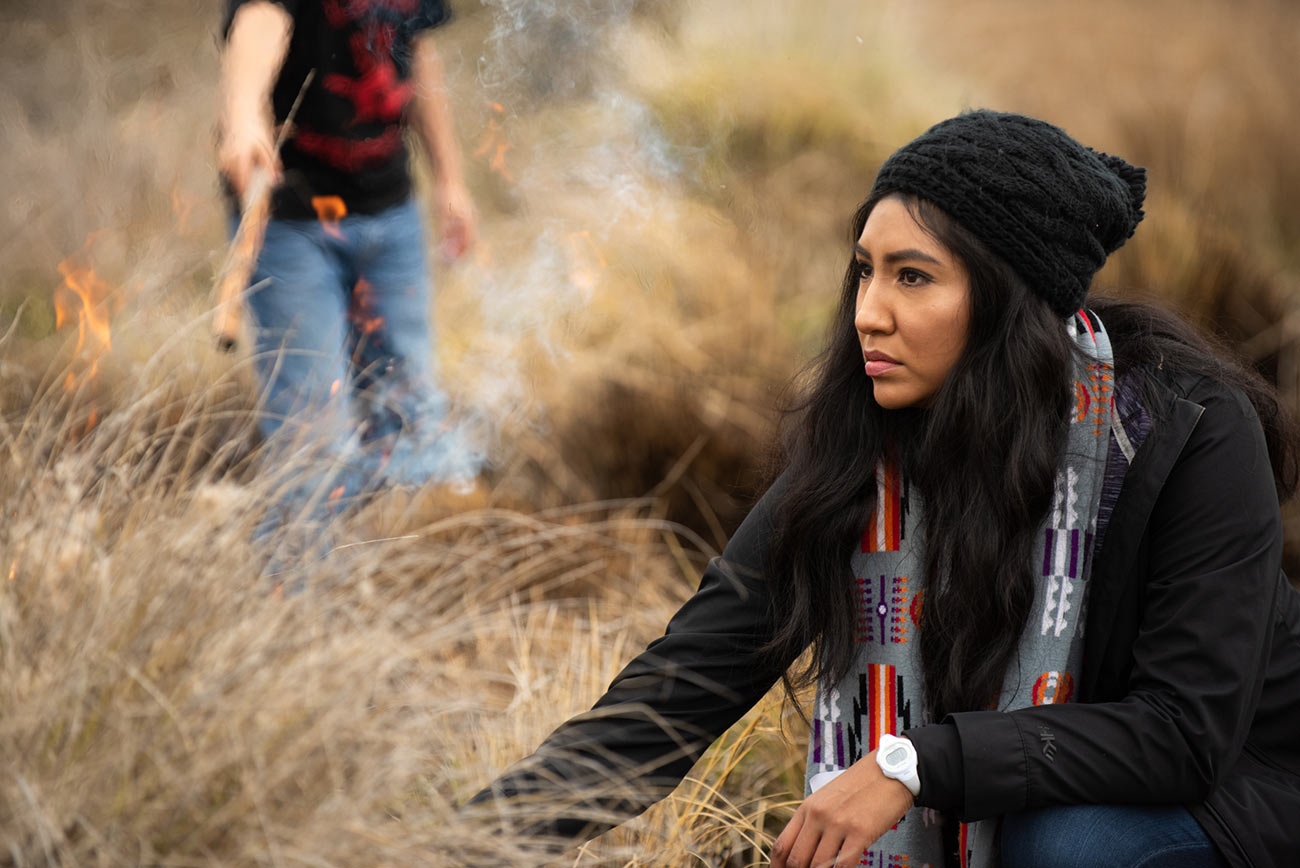
Restore, reconnect
When you learn about cultural burning and that fire can be positive and not just a tool to avoid worse fires, it’s transformative.
– Christopher Adlam
Some of the students participating in the class’s cultural burns have experienced catastrophic fire firsthand, with past seasons threatening their homes and families. But the fire they meet on this day in Mariposa is a completely different, gentle animal — one they can walk with.
“Seeing fire used for good can be healing,” Adlam said. “When you learn about cultural burning and that fire can be positive and not just a tool to avoid worse fires, it’s transformative.”
Reintroducing fire to the land through cultural burns can also help reconnect Native people with their homelands.
“It’s healing not just for the land, but for the people, too,” said Irene Vasquez, secretary for the American Indian Council, during the Mariposa burn.
Back in the sourberry patch, Dick Tex is sharing stories with a group of young students as she continues her search for the perfect, straight stick to add to the bundle in her hand.
“To come here … ” she said, pausing to breathe in, lift her chest and close her eyes, “ … it makes me feel good. For those of us who love sourberries, just the smell makes you salivate. It’s home.”
Media Resources
Kat Kerlin, UC Davis News and Media Relations, 530-750-9195, kekerlin@ucdavis.edu
